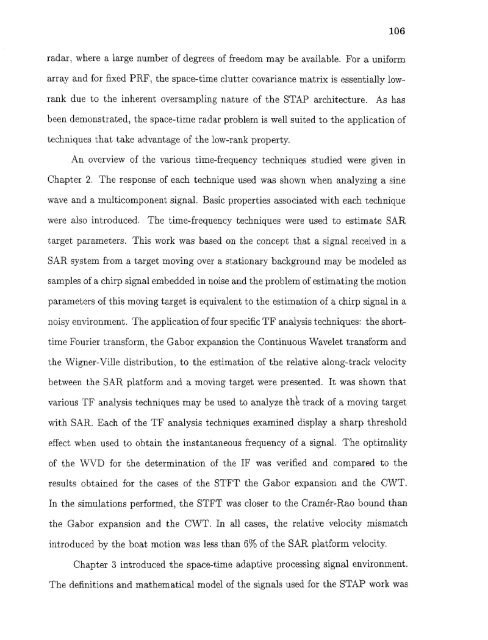Space/time/frequency methods in adaptive radar - New Jersey ...
Space/time/frequency methods in adaptive radar - New Jersey ...
Space/time/frequency methods in adaptive radar - New Jersey ...
You also want an ePaper? Increase the reach of your titles
YUMPU automatically turns print PDFs into web optimized ePapers that Google loves.
106<strong>radar</strong>, where a large number of degrees of freedom may be available. For a uniformarray and for fixed PRF, the space-<strong>time</strong> clutter covariance matrix is essentially lowrankdue to the <strong>in</strong>herent oversampl<strong>in</strong>g nature of the STAP architecture. As hasbeen demonstrated, the space-<strong>time</strong> <strong>radar</strong> problem is well suited to the application oftechniques that take advantage of the low-rank property.An overview of the various <strong>time</strong>-<strong>frequency</strong> techniques studied were given <strong>in</strong>Chapter 2. The response of each technique used was shown when analyz<strong>in</strong>g a s<strong>in</strong>ewave and a multicomponent signal. Basic properties associated with each techniquewere also <strong>in</strong>troduced. The <strong>time</strong>-<strong>frequency</strong> techniques were used to estimate SARtarget parameters. This work was based on the concept that a signal received <strong>in</strong> aSAR system from a target mov<strong>in</strong>g over a stationary background may be modeled assamples of a chirp signal embedded <strong>in</strong> noise and the problem of estimat<strong>in</strong>g the motionparameters of this mov<strong>in</strong>g target is equivalent to the estimation of a chirp signal <strong>in</strong> anoisy environment. The application of four specific TF analysis techniques: the short<strong>time</strong>Fourier transform, the Gabor expansion the Cont<strong>in</strong>uous Wavelet transform andthe Wigner-Ville distribution, to the estimation of the relative along-track velocitybetween the SAR platform and a mov<strong>in</strong>g target were presented. It was shown thatvarious TF analysis techniques may be used to analyze thè track of a mov<strong>in</strong>g targetwith SAR. Each of the TF analysis techniques exam<strong>in</strong>ed display a sharp thresholdeffect when used to obta<strong>in</strong> the <strong>in</strong>stantaneous <strong>frequency</strong> of a signal. The optimalityof the WVD for the determ<strong>in</strong>ation of the IF was verified and compared to theresults obta<strong>in</strong>ed for the cases of the STFT the Gabor expansion and the CWT.In the simulations performed, the STFT was closer to the Cramér-Rao bound thanthe Gabor expansion and the CWT. In all cases, the relative velocity mismatch<strong>in</strong>troduced by the boat motion was less than 6% of the SAR platform velocity.Chapter 3 <strong>in</strong>troduced the space-<strong>time</strong> <strong>adaptive</strong> process<strong>in</strong>g signal environment.The def<strong>in</strong>itions and mathematical model of the signals used for the STAP work was
















